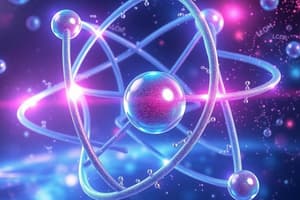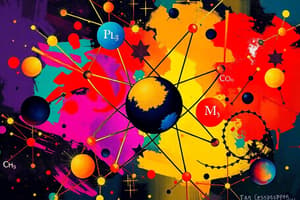Podcast
Questions and Answers
Which branch of chemistry focuses on the study of living organisms?
Which branch of chemistry focuses on the study of living organisms?
- Physical Chemistry
- Biochemistry (correct)
- Analytical Chemistry
- Organic Chemistry
Inorganic Chemistry covers all chemical compounds that are organic.
Inorganic Chemistry covers all chemical compounds that are organic.
False (B)
What is the study of matter and the changes it undergoes known as?
What is the study of matter and the changes it undergoes known as?
Chemistry
_______ Chemistry applies physics to the study of chemistry.
_______ Chemistry applies physics to the study of chemistry.
Match the following branches of chemistry with their descriptions:
Match the following branches of chemistry with their descriptions:
Which of the following is a binary acid?
Which of the following is a binary acid?
Phosphorous acid is represented by the formula H3PO4.
Phosphorous acid is represented by the formula H3PO4.
What is the molar mass of HBr?
What is the molar mass of HBr?
The percentage composition of oxygen in H2PO4 is _______.
The percentage composition of oxygen in H2PO4 is _______.
Match the following acids with their characteristics:
Match the following acids with their characteristics:
What is the empirical formula for the compound analyzed?
What is the empirical formula for the compound analyzed?
The ratio of moles of magnesium to moles of carbon is greater than 1.
The ratio of moles of magnesium to moles of carbon is greater than 1.
What is the mass of carbon in grams present in the compound?
What is the mass of carbon in grams present in the compound?
The percentage of oxygen in the compound is ___%.
The percentage of oxygen in the compound is ___%.
Match the element to its corresponding moles in the compound:
Match the element to its corresponding moles in the compound:
Which of the following particles has a positive charge?
Which of the following particles has a positive charge?
The atomic number is equal to the number of protons in an atom.
The atomic number is equal to the number of protons in an atom.
What is the term for atoms of the same element that have different masses?
What is the term for atoms of the same element that have different masses?
The part of the atom where most of the atom's mass is found is called the ______.
The part of the atom where most of the atom's mass is found is called the ______.
Match the following formulas with their types:
Match the following formulas with their types:
What does the oxidation number indicate?
What does the oxidation number indicate?
A cation is negatively charged because it gains electrons.
A cation is negatively charged because it gains electrons.
What is the formula for the compound formed by sodium and chlorine?
What is the formula for the compound formed by sodium and chlorine?
In a chemical reaction, an anion is formed when an atom ______ electrons.
In a chemical reaction, an anion is formed when an atom ______ electrons.
Match the following ions with their charges:
Match the following ions with their charges:
What does the skeletal equation for the reaction of aluminum and sulfuric acid produce?
What does the skeletal equation for the reaction of aluminum and sulfuric acid produce?
In a synthesis reaction, two or more reactants form a single product.
In a synthesis reaction, two or more reactants form a single product.
What type of reaction is represented by the equation $CaCO_3 \rightarrow CaO + CO_2$?
What type of reaction is represented by the equation $CaCO_3 \rightarrow CaO + CO_2$?
In a double replacement reaction, the general form is AB + CD → ______ + ______.
In a double replacement reaction, the general form is AB + CD → ______ + ______.
Match the following types of reactions with their general equations:
Match the following types of reactions with their general equations:
What is the empirical formula of diborane?
What is the empirical formula of diborane?
The molecular formula of diborane is B_2H_6.
The molecular formula of diborane is B_2H_6.
Calculate the molar mass of diborane (B_2H_6).
Calculate the molar mass of diborane (B_2H_6).
The multiplier used to determine the molecular formula from the empirical formula is __________.
The multiplier used to determine the molecular formula from the empirical formula is __________.
Match the following components with their respective values:
Match the following components with their respective values:
How many oxygen atoms are present in the products of the equation C2H4 + 3O2 → 2CO2 + 2H2O?
How many oxygen atoms are present in the products of the equation C2H4 + 3O2 → 2CO2 + 2H2O?
The balanced equation BaCl2 + 2Na(OH)2 → Ba(OH)2 + 2NaCl contains 6 sodium atoms.
The balanced equation BaCl2 + 2Na(OH)2 → Ba(OH)2 + 2NaCl contains 6 sodium atoms.
What is the coefficient of NaCl in the balanced equation BaCl2 + 2Na(OH)2 → Ba(OH)2 + 2NaCl?
What is the coefficient of NaCl in the balanced equation BaCl2 + 2Na(OH)2 → Ba(OH)2 + 2NaCl?
In the reaction C2H4 + 3O2 → 2CO2 + 2H2O, the total number of carbon atoms in the reactants equals ___ in the products.
In the reaction C2H4 + 3O2 → 2CO2 + 2H2O, the total number of carbon atoms in the reactants equals ___ in the products.
Match the following elements with their quantities in the reactants of the equation C2H4 + 3O2:
Match the following elements with their quantities in the reactants of the equation C2H4 + 3O2:
What is the correct name for the compound NaF?
What is the correct name for the compound NaF?
FeCl3 is also known as ferrous chloride.
FeCl3 is also known as ferrous chloride.
What is the traditional name for CuF2?
What is the traditional name for CuF2?
MgO is commonly known as __________.
MgO is commonly known as __________.
Match the following compounds with their traditional names:
Match the following compounds with their traditional names:
Flashcards are hidden until you start studying
Study Notes
Atom
- An atom is indivisible and the smallest unit of matter.
- Subatomic particles include:
- Proton (+) discovered by Ernest Rutherford.
- Electron (−) discovered by Joseph John Thomson.
- Neutron discovered by James Chadwick.
- The nucleus contains most of the atom's mass, with atomic mass calculated as the sum of protons and neutrons.
- The atomic number represents the number of protons, which equals the number of electrons in a neutral atom.
- Isotopes are variants of the same element with differing masses.
Chemical Formula
Types
- Empirical Formula represents the simplest ratio of elements.
- Examples:
- H₂O₂ simplifies to HO.
- C₄H₁₀ simplifies to C₂H₅.
- C₆H₁₂O₆ simplifies to CH₂O.
- Examples:
- Molecular Formula shows the exact number of atoms.
- Examples:
- Mg₃N₂
- Ca(OH)₂
- Examples:
Branches of Chemistry
- Analytical Chemistry: Focused on the analysis of substances.
- Biochemistry: Studies chemical processes in living organisms.
- Organic Chemistry: Deals primarily with carbon-containing compounds.
- Inorganic Chemistry: Covers compounds that are not organic.
- Physical Chemistry: Combines principles of physics with chemistry.
Acids
- Binary Acids contain hydrogen and examples include:
- HBr (hydrobromic acid)
- HF (hydrofluoric acid)
- HI (hydroiodic acid)
- Ternary Acids contain hydrogen and oxygen; examples include:
- H₃PO₄ (phosphoric acid)
- H₃PO₃ (phosphorous acid)
Molar Mass
- Molar mass is computed as the sum of atomic weights multiplied by their respective subscripts.
- Example calculations:
- For HBr:
- H: 1 × 1 = 1
- Br: 1 × 80 = 80
- Total = 81 g/mol
- For H₂PO₄:
- H: 2 × 1 = 2
- P: 1 × 31 = 31
- O: 4 × 16 = 64
- Total = 97 g/mol
- For HBr:
Percentage Composition
- Percentage of each element can be determined using:
- % of element = (number of atoms × atomic mass) / molar mass × 100
Structural Formula
- Represents the arrangement of atoms within molecules; examples include:
- H₂O depicted as H-O-H
- C₄H₁₀ depicted as H-C-C-C-C-H
Atoms and Electrons
- Atoms may gain or lose electrons, leading to oxidation states.
- Cation: Positively charged (loses electrons).
- Anion: Negatively charged (gains electrons).
Example Compounds
| Cation | Anion | Compound |
|---|---|---|
| Na⁺ | Cl⁻ | NaCl |
| K⁺ | NO₃⁻ | KNO₃ |
| Mg²⁺ | PO₄³⁻ | Mg₃(PO₄)₂ |
Chemical Applications
- To determine empirical formulas from percentage composition, convert percentages to moles, find mole ratios, and derive the simplest formula.
- Example compound with 28.82% Mg, 14.24% C, and 56.93% O results in empirical formula MgCO₃.
Molecular Formula Example
- For diborane:
- Calculate grams of boron and hydrogen.
- Find empirical formula BH₃.
- Molar mass calculation leads to molecular formula B₂H₆.
Chemical Equations
- Basic format: Reactants → Products.
- Example of word equation: Aluminum + Sulfuric acid → Hydrogen + Aluminum sulfate.
- Example of skeletal equation: ( Al_{(s)} + H_2 SO_4 \longrightarrow H_2 + Al_2 (SO_4)_3 ).
Types of Reactions
- Synthesis: A + B → AB.
- Decomposition: AB → A + B.
- Single Replacement: A + BC → AC + B.
- Double Replacement: AB + CD → AD + BC.
Naming Compounds
- Binary Ionic Compounds end in -ide (e.g., NaF - sodium fluoride).
- Compounds with metals that have varying oxidation states use Stock or Traditional nomenclature (e.g., Iron (II) chloride, ferrous chloride).
Balancing Chemical Equations
- Ensure the number of each type of atom is the same on both sides of the equation.
- Example:
- ( BaCl_2 + 2Na(OH){2} → Ba(OH){2} + 2NaCl ) balances Ba, Cl, Na, O, and H.
- ( C_2H_4 + 3O_2 → 2CO_2 + 2H_2O ) balances C, H, and O.
Studying That Suits You
Use AI to generate personalized quizzes and flashcards to suit your learning preferences.




